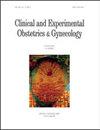孕妇与婴儿B群链球菌侵袭性的回顾性比较研究
IF 0.6
4区 医学
Q4 OBSTETRICS & GYNECOLOGY
引用次数: 0
摘要
背景:B族链球菌(GBS)是一种公认的机会致病菌,可引起孕妇及其新生儿感染。本研究的目的是通过比较孕妇和新生儿的各项指标来探讨GBS的侵袭性。方法:本回顾性研究纳入6892例连续筛查的GBS孕妇和48例GBS阳性新生儿。孕妇与新生儿的数据比较采用卡方检验和Kruskal-Wallis检验。p值≤0.05认为有统计学意义。结果:在排除其他可能导致不良妊娠结局的危险因素后,除年龄组外,gbs阳性组与gbs阴性组孕妇间无差异。gbs阴性组和阳性组早产儿、胎膜早破(PROM)、绒毛膜羊膜炎的发生率分别为1.06%和0.74%、7.72%和8.14%、0.63%和0.74%。p值分别为0.619、0.263、0.626。19-30岁组gbs阳性率为6.83%(201/2943),31-40岁组阳性率为6.89%(262/3802),41-52岁组阳性率为1.36% (2/147)(p = 0.031)。不同新生儿组各指标差异有统计学意义。数据分析显示,在gbs定植组、gbs感染组和死亡组中,分娩方式、胎龄、新生儿出生体重和Apgar评分存在显著差异(p = 0.010、0.004、0.022和0.000 <分别为0.05)。结论:排除相关因素后,表明gbs定殖独立导致孕妇不良妊娠结局的证据不足。体重过轻、健康状况不佳的早产儿更容易发生GBS。本文章由计算机程序翻译,如有差异,请以英文原文为准。
A Retrospective Study Comparing of Group B Streptococcus Invasiveness in Pregnant Women and Infants
Background: Group B streptococcus (GBS) is commonly recognized as an opportunistic pathogen, which can cause infections in pregnant women and their newborns. The aim of this study was to explore the invasiveness of GBS by comparing various indices of pregnant mothers and newborns. Methods: This retrospective study involved 6892 consecutive GBS screened pregnant women, and 48 GBS-positive newborns. The data of pregnant women and newborns was compared by Chi-square test and Kruskal-Wallis test. A p-value ≤ 0.05 was considered statistically significant. Results: After excluding the other risk factors which can cause adverse pregnancy outcomes, there were no differences between pregnant women in GBS-positive and GBS-negative groups, except the age group. In the GBS-negative and positive groups the incidence of prematurity, premature rupture of membranes (PROM), and chorioamnionitis were 1.06% and 0.74%, 7.72% and 8.14%, 0.63% and 0.74%, respectively. The corresponding p-values were 0.619, 0.263, and 0.626. The GBS-positive rate was 6.83% (201/2943) in the 19–30 years (y) group, 6.89% in the (262/3802) in the 31–40 y group, and 1.36% (2/147) in the 41–52 y group (p = 0.031). The indices in the different newborn groups exhibited significant differences. Analysis of the data revealed significant differences in delivery mode, gestational age, neonatal birth weight, and Apgar scores among the GBS-colonization, GBS-infection, and death groups (p = 0.010, 0.004, 0.022, and 0.000 < 0.05, respectively). Conclusions: After excluding related factors, the evidence showing that GBS-colonization independently induced adverse pregnancy outcomes in pregnant women was insufficient. GBS was more likely to attack premature newborns with low weight and poor health status.
求助全文
通过发布文献求助,成功后即可免费获取论文全文。
去求助
来源期刊
CiteScore
0.50
自引率
0.00%
发文量
241
审稿时长
1 months
期刊介绍:
CEOG is an international, peer-reviewed, open access journal. CEOG covers all aspects of Obstetrics and Gynecology, including obstetrics, prenatal diagnosis, maternal-fetal medicine, perinatology, general gynecology, gynecologic oncology, uro-gynecology, reproductive medicine, infertility, reproductive endocrinology, sexual medicine. All submissions of cutting-edge advances of medical research in the area of women''s health worldwide are encouraged.

 求助内容:
求助内容: 应助结果提醒方式:
应助结果提醒方式:


